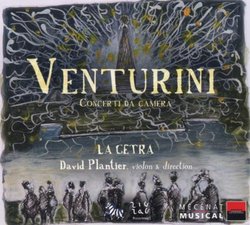| All Artists: Venturini, La Cetra, Plantier Title: Concerti Da Camera Op. 1 Members Wishing: 0 Total Copies: 0 Label: Zig Zag Territories Release Date: 12/31/2007 Genre: Classical Styles: Chamber Music, Historical Periods, Classical (c.1770-1830) Number of Discs: 1 SwapaCD Credits: 1 UPC: 3760009291133 |
Search - Venturini, La Cetra, Plantier :: Concerti Da Camera Op. 1
CD Details |
CD ReviewsCornucopia of fantastic music from Hanover Morten Fuglestad | Norway | 12/02/2008 (5 out of 5 stars) "If you enjoyed La Cetra's recently recorded CD of music by Brescianello (Harmonia Mundi France), this CD with music from Francesco Venturini's (ca.1675-1745) Opus 1, (publ. in Amsterdam in ca.1715) "Concerti da Camera" will not let you down.
Venturini was, in spite of his Italianate name, born a Flemish. His mixture of Italian and French style is often idosyncratic compared to Telemann and JS Bach, but his music is extremely individual and rewarding (at least to my "lay-ears"). This is one of the most fascinating composers come to light recently, along with Graupner and Heinichen. The comparisson to Dresden is apt in the sense that basslines tend to underpin unpredictable and long themes with surprising pauses and rethorical figures. The instrumentation is also in keeping with the Dresden gusto barbarico with oboes in pairs not playing so much colla parte, but having independent and complementary themes. Recorders with small cadenzas dropping in and out of the movements is another peculiarity that adds both colour and new meaning to previously introduced themes. The structural level of this music is also quite surprising. The title of his opus 1, "Concerti da Camera", may be a little confusing in that the works are called sonatas and, played by a sizeble orchestra. The first movements are either an Overture or a Concerto. The Concerto is a movement with fast outer sections and a brief slow section played attaca and knitting the movement together. The Sonata II has a particulary impressive cadanza for solo violin (I guess it is played by David Plantier) in its concerto-movement. The Overtures have, like the concerto-movements, concertante instruments playing against the string ripieno, but not in the sobre style of Telemann - Venturini surprises us with introduction of solo instruments in always new combinations and styles - i.e. a sudden French twist with pairs of oboes and bassoon, then an Italianate concertino of single or pairs of violins to round off a phrase played by two recorders. The playing of La Cetra under primo violino David Plantier show us that this Basle based orchestra is in world league (at least on record, as I havn't heard them live). They play with real brio and their taste in the choice of embelishments are equisite. Plaudits should also be given for their research of previously un-recorded material. Bravo!!!" |

